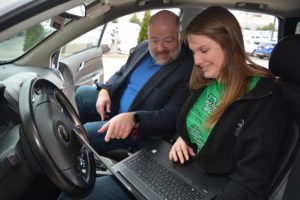
John Sammons, associate professor and director of the Marshall University digital forensics and information assurance program, is conducting vehicle forensics research that could enhance capabilities for law enforcement in the U.S.
Sammons, interim chair of the department of forensic science, said he will present this research Thursday, Feb. 16, at the 69th Annual Scientific Meeting of the American Academy of Forensic Sciences in New Orleans.
“The connected cars on the road today represents a significant new source of potential evidence. This evidence could have significant impact on criminal and civil litigation,” Sammons said. “Like many digital devices, connected cars capture and store a wide variety of data, much of which is unbeknownst to the user and hard to get rid of. One of the major challenges presented by new evidentiary sources is recognizing them in the first place. We hope this project will help raise the level of awareness.”
Sammons said this project was done in partnership with the National White Collar Crime Center (NW3C), which is located in Fairmont, West Virginia. The NW3C delivers digital evidence training to state and local law enforcement agencies across the country. One of the products from this research partnership is a white paper intended to introduce this topic to state and local law enforcement officers throughout the United States.
Sammons noted since 2010, NW3C has trained more than 46,000 employees from 27,140 state and local agencies within the United States in cybersecurity, cybercrime and cyber-investigations.
“Digital forensic practitioners face many challenges, not the least of which is the sheer volume of data that is collected,” Sammons said. “Labs across the country are facing huge case backlogs. Practitioners often rely on commercial tools to make their work faster and more efficient. Currently there is only one commercial tool on the market for vehicle forensics. Using this tool, we want to see what’s possible and attempt to identify the challenges facing the folks in the field.”
Sammons said the best thing about the partnership with the NW3C are the opportunities for Marshall students. One of these students is Celia Whelan, who recently presented her vehicle forensics research at Eastern Kentucky University’s student chapter of the High Technology Crime Investigation Association. Whelan, 24, is working to earn her master’s degree in forensic science with an emphasis in digital forensics.
“Vehicle forensics is a brand-new area of study and many law enforcement officials may not realize it can be an extremely useful tool in an investigation,” Whelan said. “The forensic science program at Marshall is unique in that it allows you to explore different areas of forensics. It’s amazing that our professors encourage us to think outside of the box and to pursue study in these new areas of forensics.”
For more information on Marshall’s digital forensic science program, e-mail forensics@marshall.edu or visit www.marshall.edu/forensics.